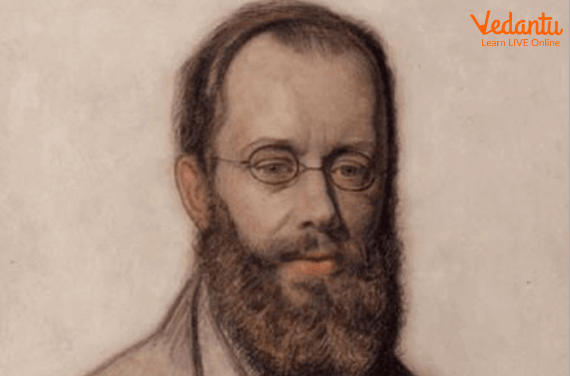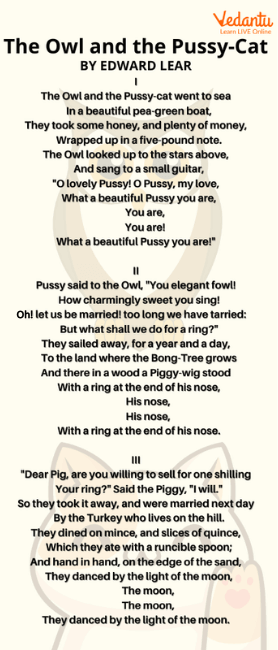Are you someone who enjoys reading poems? What type of poem do you like? Do you know there are different types of poems and different poets have different writing styles? Do you know different poems have different rhythms? If you already know all of these, then it’s a very good thing but in case you don’t know about these, you are going to learn about these now. In this article, we are going to learn about a very famous personality and his unique style of poems. Let us first know who he was?
Who was Edward Lear?
Edward Lear was an English painter, illustrator, author, and poet who is most known for his literary nonsense in poetry and prose, particularly his limericks, a form of poetry which he popularised. His true brilliance shines through in his nonsense poetry, which depict a universe of fantastic creatures in gibberish words, frequently implying a deep sense of sorrow. His appealing pen-and-ink graphics, particularly in the limericks, equal their excellence.

Edward Lear
Life of Edward Lear
The great personality Edward Lear was born on 12th May, 1812. Edward began his career as an artist at age 15. Lear, the 21st child of Ann and Jeremiah Lear, was born into a middle-class family in the village of Holloway. His elder sister, Ann, who is 21 years his senior, was his sole carer. When Lear was thirteen years old, his father, a Danish stockbroker, was sentenced to debtor's jail, and the young Lear was forced to work. Lear's work quickly gained recognition, and in 1832, he was hired by the London Zoological Society to illustrate birds. In the same year, the Earl of Derby invited Lear to live on his estate where he stayed until 1836.
He had frequent grand mal epileptic seizures since the age of six, as well as bronchitis, asthma, and, later in life, partial blindness. Lear began to show signs of depression around the age of seven, possibly as a result of his childhood's constant instability. Throughout his life, Lear travelled extensively and eventually settled in Sanremo, on his beloved Mediterranean coast, in the 1870s, at a villa he named "Villa Tennyson." Lear died at his villa in 1888, after a long decline in his health, of heart disease, which he had been suffering from since at least 1870. The wife of Dr. Hassall, Lear's physician, described Lear's funeral as a sad, lonely affair, with none of Lear's many lifelong friends able to attend.
Although Lear was a possessor of versatility, we will talk about his poetic skills here in this article.
Edward Lear as an Author and Poet
Lord Derby invited Lear to draw the menagerie on his estate of Knowsley while he was working at the zoo. During his four years there, he became a favourite of the grandchildren. He wrote his first Nonsense Book for them, a collection of 50 limericks illustrated with delightful nonsense drawings. Trips to northern England at this time sparked a desire to paint romantic landscapes, especially since close drawing was causing him vision problems. He made the decision to travel to Rome, where he hoped to sell his watercolours to English residents. Until 1848, Rome was his base of operations, from which he travelled throughout Europe, Asia, and Africa in search of subject matter for his landscape paintings.
The desire to improve his art compelled Lear to leave a legacy to study at the Royal Academy of Arts in London. He was discouraged after two years of the slow, outmoded course. He accepted Holman Hunt's invitation to exchange Italian lessons for assistance with oil painting. The friendship was fruitful. Hunt took on the moniker "Daddy Hunt", providing artistic support to the older, lonely man. Between 1840 and 1853, he painted a number of oil landscapes, the most ambitious of which he displayed at the Royal Academy from 1850 to 1853. They didn't sell for the price he asked, so he went back to smaller watercolours and lithographs for his travel books.
Lear met the children for whom he wrote the poems and prose and drew the illustrations, which were published at intervals between 1846 and 1877. He created the inimitable "Owl and the Pussy Cat", "The Pobble's Toes", "The Jumblies", and other characters for casually met child friends. Holbrook Jackson's The Complete Nonsense of Edward Lear is a complete collection of Lear's nonsense poetry with an excellent introduction (1951).
During Lear's lifetime, his nonsense novels were immensely famous, but there was a notion that "Edward Lear" was just a pseudonym, and the genuine author of the books was the man to whom Lear had dedicated the works, his patron the Earl of Derby. Lear's nonsense works are characterised by a poet's delight in the sounds of words, both real and imagined, and a skill for verbal creativity. A "diaphanous doorscraper" is made out of a stuffed rhinoceros. "A perpendicular, spicular, orbicular, quadrangular, circular depth of soft mud" plunges a "Blue Boss-Woss." Quangle-Wangles, Pobbles, and Jumblies are his heroes. A "runcible spoon," which appears in the closing lines of The Owl and the Pussycat and is now found in many English dictionaries, is his most renowned piece of word invention.

Edward Lear’s Limmericks
Edward Lear’s Limericks
Although today's limericks are always typeset as four plus one lines, Lear's limericks were published in a variety of styles. Lear appears to have written them in manuscript, with as many lines as there was place for beneath the illustration. The majority of the first three editions are typeset as two, five, and three lines, respectively. One edition's cover features a full limerick typeset in two lines:
“There was an Old Derry down Derry, who loved to see little folks merry;
So he made them a book, and with laughter they shook at the fun of that Derry down Derry.”
Instead of rhyming, the first and last lines of Lear's limericks frequently conclude with the same word. They are, for the most part, completely absurd and devoid of any sort of punch line or point. They are devoid of the off-colour humour that has become synonymous with the poetry form. The presence of a callous and critical "they" is a common thematic motif. The following is an example of a standard Lear limerick:
There was an Old Man of Aôsta,
Who possessed a large Cow, but he lost her;
But they said, ‘Don’t you see,
she has rushed up a tree?
You invidious Old Man of Aôsta’
The Theme of Edward Lear’s Poems
The use of language play and other distancing tactics to derive humour from cruelty, agony, and death are common themes in Lear's poetry, as they are in the nonsense verse of Lewis Carroll, Thomas Hood, W.S. Gilbert, and other Victorians. Surrealism and the theatre of the absurd were two 20th-century aesthetic groups that were influenced by nonsense poems. However, it also incorporates themes that are specific to Lear's own experience. It is, above all, an expression of a lovable and extremely loving man who, despite the deep affection of innumerable relatives, friends, and readers — children and adults — was never loved in the personal, exclusive, and consistent manner he so fervently craved.
Works of Edward Lear
Following is the list of Edward Lear’s works:
Illustrations of the Family of the Psittacidae, or Parrots (1832)
Views in Rome and its Environs (1841)
Mount Timohorit, Albania (1848)
Tortoises, Terrapins, and Turtles by J.E. Gray
Gleanings from the Menagerie at Knowsley Hall (1846)
Illustrated Excursions in Italy (1846)
Book of Nonsense (1846)
Journal of a Landscape Painter in Greece and Albania (1851)
Journal of a Landscape Painter in Southern Calabria (1852)
Book of Nonsense and More Nonsense (1862)
Views in the Seven Ionian Isles (1863)
Journal of a Landscape Painter in Corsica (1870)
Nonsense Songs and Stories (1871)
More Nonsense Songs, Pictures, etc. (1872)
Laughable Lyrics (1877)
Nonsense Alphabets
Nonsense Botany (1888)
Tennyson’s Poems, illustrated by Lear (1889)
Facsimile of a Nonsense Alphabet (1849, but not published until 1926)
The Scroobious Pip, unfinished at his death, but completed by Ogden Nash and illustrated by Nancy Ekholm Burkert (1968)
The Quangle-Wangle’s Hat (unknown)
Despite the fact that the content and structure of his works vary widely, all of Lear's poems are distinguished by his sarcastic view of the world; in "By Way of a Preface," Lear poked fun at himself. Many critics see Lear's commitment to the absurd as a way of dealing with or undermining Victorian society's all-pervasive orderliness and diligence. The humour of Lear's poetry has proven irrefutably timeless, regardless of impetus.


FAQs on The Multi-Talented Poet Edward Lear’s Poems
1. What is the nonsense verse?
Nonsense verse is a hilarious or whimsical verse that defies rational or metaphorical explanation, unlike other comedic verse. It is unlike the ritualistic nonsense of children's counting-out rhymes in that it makes these words sound meaningful, despite the fact that it frequently uses coined, meaningless terms.
2. How many of Lear's translated works were set for music?
Goffredo Petrassi put five of Lear's limericks from the Book of Nonsense to music for choir a cappella in 1952, based on Carlo Izzo's 1946 Italian translation.





